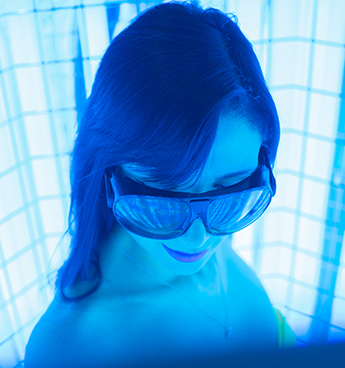
Narrowband UVB is the most common form of phototherapy used to treat inflammatory skin conditions.
It is extremely effective for psoriasis but has also been used in treatment of atopic dermatitis (eczema), vitiligo, polymorphic light eruption, generalized pruritus (itch) and many other skin conditions.

The effectiveness of
Narrowband UVB Phototherapy
‘Narrowband’ refers to the wavelength of ultraviolet B (UVB) light from 311nm to 312nm. This wavelength makes up a small component of our natural sunlight. The narrow wavelength makes it a safer and more effective option than:
- Conventional ‘broad UVB’: From 290nm to 320nm
- PUVA: A type of phototherapy using an oral medication, a psoralen and UVA light
- Natural sunlight
the side effects and risks of
Narrowband UVB
Narrowband UVB can result in sunburn just like natural sunlight. The treatment regime tends to involve a gradual increase in dose throughout the course in order to achieve faster and more complete outcome. Due to this, it is expected that most patients will experience a mild sunburn at least once during the phototherapy course. Importantly, these mild sunburn from UVB are not dangerous.
Just like UV light which exist in sunlight, narrowband UVB can damage DNA, therefore a natural concern from many about its potential to cause skin cancers. However, cumulative scientific research over the decades have shown that there are no, or negligible increased risk of skin cancer with narrowband UVB phototherapy in humans.
This is different to chronic sunlight exposure, UVA tanning machine and PUVA, which have increased risks of causing skin cancers. The exact reason behind this is unknown but it has been hypothesized that the short wavelength of the UVB light allows it to be readily absorbed into the most superficial layer of the skin instead of going deep into the skin causing skin damage and leading to skin cancer.
Phototherapy is safer than systemic agents such as prescription tablets or injections. When topical treatments (cream and ointments) are insufficient, narrow band UVB is often considered the first line treatment of choice for skin conditions such as psoriasis, vitiligo and eczema. It also has a safe profile for use in pregnant women and children. It has the added benefit of minimising serious side effects from systemic medications. Furthermore, it does not require routine monitoring blood tests that are required with systemic medications.

What does narrowband UVB treatment involve?
Patient usually attend for UVB treatment two to three times a week. The course usually lasts from six to ten weeks depending on the response. Treatment is completely ceased after the skin condition has cleared or improved. It can be restarted later if the condition relapses. Maintenance treatments are recommended for some more difficult to treat skin conditions.
Whole body treatment (for conditions affecting wide areas of the body): patients stand in the centre of a special phototherapy cabinet while undressed down to undergarments, wearing protective goggles or a facemask. The treatment lasts seconds to several minutes. The dose of UV is tailored to the patient’s condition, skin type, skin condition, previous response to treatment and other factors. The dermatologist and phototherapy staff will keep a close eye on the treatment progress and response.
Localised treatment (for conditions localised to certain areas): only affected areas will be exposed to UVB therapy in special hand and foot units.
What is the result of narrowband UVB?
The majority of patients with psoriasis will improve with phototherapy. Patches generally start to become thinner after five to ten treatments. Results vary but most psoriasis responds within 15 to 25 treatments.
The responses to UVB for other inflammatory skin conditions are more variable. Our dermatologist will discuss expectations with you.
Phototherapy is affordable and convenient
At Queensland Specialist Dermatology, the costs of phototherapy are fully covered by Medicare. Treatment time is usually a few minutes or less. Treatments are available at all times during our operating hours. Priority parking is available.

